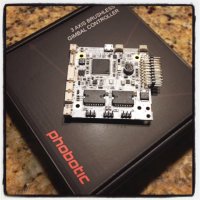Motopreserve
Drone Enthusiast
Figured I'd start this thread for the folks that own, and are now actually using the Phobotic CenterPiece gimbal controller (both the standard or high voltage versions). Based on following the original threads (on forums to remain nameless), I'd ask that we keep this....if not professional, at least civil 
It's still early days for this controller, but already people have experienced things they really like about it, such as a modern looking GUI (launched as a Google Chrome app on Mac or PC), direct customer support contact with the company (and the developers!), full-feature set (extensive RC connectivity such as sbus, status feedback via LED etc) and not least the auto-tune function. One standout feature of the current firmware implements a 'send report' function which gathers the data from your controller and forwards it to Phobotic for review. This has enabled the company to diagnose specific issues, as well as gather vast data to better direct and focus its efforts to improve the product.
For the uninitiated, the CenterPiece aims to offer a one button solution to tuning the gimbal. While other controllers offer this feature, the common consensus has been that they are A) financially out of reach for the average consumer (Movi) or B) if more reasonably priced, do not work very well (AlexMos 32bit). The CenterPiece auto-Tune is initiated by the GUI or by the push of a button, and begins a series of gyrations that reads the full camera mount system, honing in on baseline values that can adapt for various gimbals and cameras/lenses.
For those who wish to manually tune their controller, the list of parameters to tweak is VERY extensive. As Roee (Phobotic owner and Samur here on the forum) has stated, the auto-tune (AT) should be able to better evaluate and mechanically adjust these parameters than a any human. For some, taking tuning control away from the end user may seem intimidating, but rest assured, a happy 'balance' can be stuck by first using auto-tune, and then fine tuning manually, to address any issues that may remain after the AT has completed.
One thing that has become apparent through early-adopters experiences is that the setup of the gimbal is extremely important for a successful AT. While some have seen this as unique to the CenterPiece, it begs the question of whether 'flaws,' or weakness in a camera mount have been present all along, but were not as obvious with other controllers. Perhaps less than ideal gimbals/mounts have been causing some of the difficulties many of us have experienced?
Personally, I found that I needed to stiffen the dampening system quite a bit (replaced the stock silicone dampeners), and very securely hold the MR on the floor to get a successful AT. It turns out that the movements the AT creates vibrated the entire VulcanUAV because of flex in the stock aluminum landing gear. While this flex is welcomed during landing - it did not play nice with the AT.
Hopefully this thread can act as a place to peacefully share real-world experiences, and help users maximize performance results....
It's still early days for this controller, but already people have experienced things they really like about it, such as a modern looking GUI (launched as a Google Chrome app on Mac or PC), direct customer support contact with the company (and the developers!), full-feature set (extensive RC connectivity such as sbus, status feedback via LED etc) and not least the auto-tune function. One standout feature of the current firmware implements a 'send report' function which gathers the data from your controller and forwards it to Phobotic for review. This has enabled the company to diagnose specific issues, as well as gather vast data to better direct and focus its efforts to improve the product.
For the uninitiated, the CenterPiece aims to offer a one button solution to tuning the gimbal. While other controllers offer this feature, the common consensus has been that they are A) financially out of reach for the average consumer (Movi) or B) if more reasonably priced, do not work very well (AlexMos 32bit). The CenterPiece auto-Tune is initiated by the GUI or by the push of a button, and begins a series of gyrations that reads the full camera mount system, honing in on baseline values that can adapt for various gimbals and cameras/lenses.
For those who wish to manually tune their controller, the list of parameters to tweak is VERY extensive. As Roee (Phobotic owner and Samur here on the forum) has stated, the auto-tune (AT) should be able to better evaluate and mechanically adjust these parameters than a any human. For some, taking tuning control away from the end user may seem intimidating, but rest assured, a happy 'balance' can be stuck by first using auto-tune, and then fine tuning manually, to address any issues that may remain after the AT has completed.
One thing that has become apparent through early-adopters experiences is that the setup of the gimbal is extremely important for a successful AT. While some have seen this as unique to the CenterPiece, it begs the question of whether 'flaws,' or weakness in a camera mount have been present all along, but were not as obvious with other controllers. Perhaps less than ideal gimbals/mounts have been causing some of the difficulties many of us have experienced?
Personally, I found that I needed to stiffen the dampening system quite a bit (replaced the stock silicone dampeners), and very securely hold the MR on the floor to get a successful AT. It turns out that the movements the AT creates vibrated the entire VulcanUAV because of flex in the stock aluminum landing gear. While this flex is welcomed during landing - it did not play nice with the AT.
Hopefully this thread can act as a place to peacefully share real-world experiences, and help users maximize performance results....

